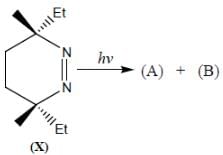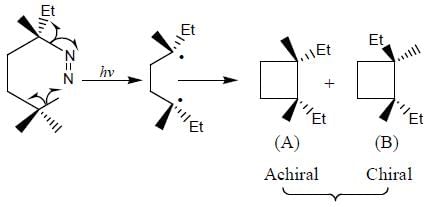Chemistry Exam > Chemistry Questions > Compound (X) on direct irradiation yield (A) ...
Start Learning for Free

Compound (X) on direct irradiation yield (A) and (B). Correct statement about reaction
- a)This reaction is stereospecific reaction
- b)Both compounds (A) and (B) are optically inactive
- c)Both compounds (A) and (B) are optically active
- d)This reaction is non-stereospecific reaction
Correct answer is option 'D'. Can you explain this answer?
| FREE This question is part of | Download PDF Attempt this Test |
Verified Answer
Compound (X) on direct irradiation yield (A) and (B). Correct statemen...

Direct irradiation yield singlet bradicals whereas use of sensitizer normally produce a triplet biradical. Triplet biradicals have a longer lifetime and therefore, more chance of bond rotation and loss of stereochemistry. Because they must undergo spin inversion before the ring close. So, they are non-stereospecific reaction.

|
Explore Courses for Chemistry exam
|

|
Similar Chemistry Doubts
Compound (X) on direct irradiation yield (A) and (B). Correct statement about reactiona)This reaction is stereospecific reactionb)Both compounds (A) and (B) are optically inactivec)Both compounds (A) and (B) are optically actived)This reaction is non-stereospecific reactionCorrect answer is option 'D'. Can you explain this answer?
Question Description
Compound (X) on direct irradiation yield (A) and (B). Correct statement about reactiona)This reaction is stereospecific reactionb)Both compounds (A) and (B) are optically inactivec)Both compounds (A) and (B) are optically actived)This reaction is non-stereospecific reactionCorrect answer is option 'D'. Can you explain this answer? for Chemistry 2024 is part of Chemistry preparation. The Question and answers have been prepared according to the Chemistry exam syllabus. Information about Compound (X) on direct irradiation yield (A) and (B). Correct statement about reactiona)This reaction is stereospecific reactionb)Both compounds (A) and (B) are optically inactivec)Both compounds (A) and (B) are optically actived)This reaction is non-stereospecific reactionCorrect answer is option 'D'. Can you explain this answer? covers all topics & solutions for Chemistry 2024 Exam. Find important definitions, questions, meanings, examples, exercises and tests below for Compound (X) on direct irradiation yield (A) and (B). Correct statement about reactiona)This reaction is stereospecific reactionb)Both compounds (A) and (B) are optically inactivec)Both compounds (A) and (B) are optically actived)This reaction is non-stereospecific reactionCorrect answer is option 'D'. Can you explain this answer?.
Compound (X) on direct irradiation yield (A) and (B). Correct statement about reactiona)This reaction is stereospecific reactionb)Both compounds (A) and (B) are optically inactivec)Both compounds (A) and (B) are optically actived)This reaction is non-stereospecific reactionCorrect answer is option 'D'. Can you explain this answer? for Chemistry 2024 is part of Chemistry preparation. The Question and answers have been prepared according to the Chemistry exam syllabus. Information about Compound (X) on direct irradiation yield (A) and (B). Correct statement about reactiona)This reaction is stereospecific reactionb)Both compounds (A) and (B) are optically inactivec)Both compounds (A) and (B) are optically actived)This reaction is non-stereospecific reactionCorrect answer is option 'D'. Can you explain this answer? covers all topics & solutions for Chemistry 2024 Exam. Find important definitions, questions, meanings, examples, exercises and tests below for Compound (X) on direct irradiation yield (A) and (B). Correct statement about reactiona)This reaction is stereospecific reactionb)Both compounds (A) and (B) are optically inactivec)Both compounds (A) and (B) are optically actived)This reaction is non-stereospecific reactionCorrect answer is option 'D'. Can you explain this answer?.
Solutions for Compound (X) on direct irradiation yield (A) and (B). Correct statement about reactiona)This reaction is stereospecific reactionb)Both compounds (A) and (B) are optically inactivec)Both compounds (A) and (B) are optically actived)This reaction is non-stereospecific reactionCorrect answer is option 'D'. Can you explain this answer? in English & in Hindi are available as part of our courses for Chemistry.
Download more important topics, notes, lectures and mock test series for Chemistry Exam by signing up for free.
Here you can find the meaning of Compound (X) on direct irradiation yield (A) and (B). Correct statement about reactiona)This reaction is stereospecific reactionb)Both compounds (A) and (B) are optically inactivec)Both compounds (A) and (B) are optically actived)This reaction is non-stereospecific reactionCorrect answer is option 'D'. Can you explain this answer? defined & explained in the simplest way possible. Besides giving the explanation of
Compound (X) on direct irradiation yield (A) and (B). Correct statement about reactiona)This reaction is stereospecific reactionb)Both compounds (A) and (B) are optically inactivec)Both compounds (A) and (B) are optically actived)This reaction is non-stereospecific reactionCorrect answer is option 'D'. Can you explain this answer?, a detailed solution for Compound (X) on direct irradiation yield (A) and (B). Correct statement about reactiona)This reaction is stereospecific reactionb)Both compounds (A) and (B) are optically inactivec)Both compounds (A) and (B) are optically actived)This reaction is non-stereospecific reactionCorrect answer is option 'D'. Can you explain this answer? has been provided alongside types of Compound (X) on direct irradiation yield (A) and (B). Correct statement about reactiona)This reaction is stereospecific reactionb)Both compounds (A) and (B) are optically inactivec)Both compounds (A) and (B) are optically actived)This reaction is non-stereospecific reactionCorrect answer is option 'D'. Can you explain this answer? theory, EduRev gives you an
ample number of questions to practice Compound (X) on direct irradiation yield (A) and (B). Correct statement about reactiona)This reaction is stereospecific reactionb)Both compounds (A) and (B) are optically inactivec)Both compounds (A) and (B) are optically actived)This reaction is non-stereospecific reactionCorrect answer is option 'D'. Can you explain this answer? tests, examples and also practice Chemistry tests.

|
Explore Courses for Chemistry exam
|

|
Suggested Free Tests
Signup for Free!
Signup to see your scores go up within 7 days! Learn & Practice with 1000+ FREE Notes, Videos & Tests.


















